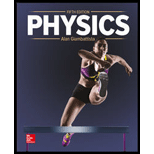
Concept explainers
(a)
Whether the central maximum be narrower or wider if red light is used instead of blue in the single-slit experiment.
(a)
Answer to Problem 51P
The central maximum will be
Explanation of Solution
Given that the width of the central maximum when blue light is used is
Write the condition for the diffraction minima in a single-slit diffraction.
Here,
Equation (I) is used mainly for dark spots on the screen. The width of the central maximum can be quantified as the distance between the minima on each side with
From equation (II) it is clear that larger wavelengths give larger angles for the first minimum.
In this case, the width of the central bright fringe is twice the distance from the center of the screen to the first minimum so that the fringe is wider for greater wavelengths. The wavelength of the red light is greater than the wavelength of the blue light so that the central maximum is wider for the red light than it is for the blue light.
Conclusion:
Therefore, the central maximum will be
(b)
The width of the central maximum when red light is used.
(b)
Answer to Problem 51P
The width of the central maximum when red light is used is
Explanation of Solution
Given that the wavelength of the blue light is
Let the width of the central maximum is
Here,
Write the expression for the distance
Here,
Use equation (IV) in equation (III),
The angle
Solve equation (II) for
Use equation (VI) in equation (V) to find
Apply equation (VII) for the red light,
Apply equation (VII) for the blue light,
Divide equation (VIII) by (IX) and solve for
Conclusion:
Substitute
Therefore, the width of the central maximum when red light is used is
Want to see more full solutions like this?
Chapter 25 Solutions
Physics
- Pls help ASAParrow_forward12. A motorboat traveling 6 m/s, West encounters a water current travelling 3.5 m/s, South. a) Draw a vector diagram showing the resultant velocity, then determine the resultant velocity of the motorboat. b) If the width of the river is 112 m wide, then how much time does it take for the boat to travel shore to shore? c) What distance downstream does the boat reach the opposite shore?arrow_forwardLake Erie contains roughly 4.00⋅10114.00⋅1011 m3 of water. Assume the density of this water is 1000. kg/m3 and the specific heat of water is 4186 J/kg˚C. It takes 2.31x10^19 J of energy to raise the temperature of that volume of water from 12.0 °C to 25.8 ˚C. An electric power plant can produce about 1110 MW. How many years would it take to supply this amount of energy by using the 1110 MW from an electric power plant?arrow_forward
- Pls help ASAParrow_forwardPls help ASAParrow_forwardm m $2° 15. A truck is stopped at a red light. Once the light turns green, the truck accelerates forward at 1.75- that same instant, a car moving with a constant speed of 50 — passes the truck. a) How many seconds will it take for the truck to catch up to the car? S b) How many metres will the truck travel before it catches up to the car? Atarrow_forward
- Pls help ASAParrow_forwardI need help adding more information to my study guide. This is subject is physics My topic : Emission Spectrum Target Material I need information on this topic but make it as study guide form and make 5 questions and include the answers.arrow_forwardAn electron and a proton are each moving at 755 km/s in perpendicular paths as shown in (Figure 1). Find the magnitude of the total magnetic force that the electron exerts on the proton. Find the magnitude of the total electrical force that the electron exerts on the proton.arrow_forward
 College PhysicsPhysicsISBN:9781305952300Author:Raymond A. Serway, Chris VuillePublisher:Cengage Learning
College PhysicsPhysicsISBN:9781305952300Author:Raymond A. Serway, Chris VuillePublisher:Cengage Learning University Physics (14th Edition)PhysicsISBN:9780133969290Author:Hugh D. Young, Roger A. FreedmanPublisher:PEARSON
University Physics (14th Edition)PhysicsISBN:9780133969290Author:Hugh D. Young, Roger A. FreedmanPublisher:PEARSON Introduction To Quantum MechanicsPhysicsISBN:9781107189638Author:Griffiths, David J., Schroeter, Darrell F.Publisher:Cambridge University Press
Introduction To Quantum MechanicsPhysicsISBN:9781107189638Author:Griffiths, David J., Schroeter, Darrell F.Publisher:Cambridge University Press Physics for Scientists and EngineersPhysicsISBN:9781337553278Author:Raymond A. Serway, John W. JewettPublisher:Cengage Learning
Physics for Scientists and EngineersPhysicsISBN:9781337553278Author:Raymond A. Serway, John W. JewettPublisher:Cengage Learning Lecture- Tutorials for Introductory AstronomyPhysicsISBN:9780321820464Author:Edward E. Prather, Tim P. Slater, Jeff P. Adams, Gina BrissendenPublisher:Addison-Wesley
Lecture- Tutorials for Introductory AstronomyPhysicsISBN:9780321820464Author:Edward E. Prather, Tim P. Slater, Jeff P. Adams, Gina BrissendenPublisher:Addison-Wesley College Physics: A Strategic Approach (4th Editio...PhysicsISBN:9780134609034Author:Randall D. Knight (Professor Emeritus), Brian Jones, Stuart FieldPublisher:PEARSON
College Physics: A Strategic Approach (4th Editio...PhysicsISBN:9780134609034Author:Randall D. Knight (Professor Emeritus), Brian Jones, Stuart FieldPublisher:PEARSON





